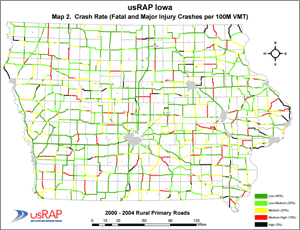Researchers
Reginald Souleyrette
About the research
As part of a larger study, CTRE conducted a pilot program in Iowa to assess the feasibility of a US Road Assessment Program (USRAP). Based on EuroRAP concepts, the usRAP pilot studies have tested two potential protocols for safety assessment and mapping of roadway systems. These are 1) risk mapping to document the risk of death and serious injury crashes and show where risk is high and low and 2) star ratings based on inspection of roads to examine how well they protect users from crashes and from deaths and serious injuries when crashes occur. CTRE has continued work on phases 2 and 3. See the usRAP website above for more information.
Researchers
Tom McDonald
About the research
The research described in this report focuses on the magnitude and severity of run-off-road collisions, evaluates federal and state guidance regarding when edge drop-offs should be addressed, and provides measures for the quantity and depth of edge drop-offs on representative rural two-lane roadways in the United States. This information is necessary and required for states and counties to determine the economic benefits from addressing pavement edge drop-offs, to understand the importance of this aspect of the AASHTO Strategic Highway Safety Plan, and to subsequently focus the limited maintenance resources necessary to mitigate this roadway problem.
One of the main goals of this research was to quantify the magnitude of edge drop-off on rural two-lane paved roadways. As discussed in Chapter 4, 21 counties in Iowa and 2 districts in Missouri were selected to provide a representative sampling of the magnitude and amount of edge drop-off present in each state. Pavement edge drop-off height and the shape of the drop-off, as well as other road characteristics such as lane width, shoulder type, and shoulder width, were documented along 150 segments in Iowa and 71 segments in Missouri on rural two-lane paved roadways with unpaved shoulders. Data were collected at a randomly selected 0.1-mile section for each mile of segment. Segments were 2 miles or longer. Although both states are in the Midwest, rural two-lane paved roadways vary significantly in maintenance guidelines, topography, soil conditions, and paved shoulder policies.
Results indicate that a very small percentage of drop-off sampled in Iowa was 5.0 inches in height (less than 0.1%), less than 1% was equal to or greater than 4.0 inches, roughly 1% was equal to or greater than 3.0 inches, and slightly more than 12% was equal to or greater than 2.0 inches. In Missouri, a very small percentage of drop-off sampled was greater than or equal to 5.0 inches (0.11%), less than 1% was equal to or greater than 4.0 inches, 3.0% was equal to or greater than 3.0 inches, and 18.6% was equal to or greater than 2.0 inches.
